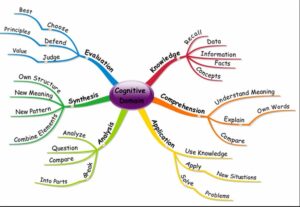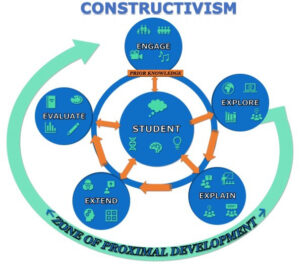Reflection on Theories of knowledge and learning- Putting Theory into Practice
To commence, it is crucial to establish a clear understanding of what learning involves and the mechanisms through which it takes place. This groundwork is essential for delving deeply into my personal teaching philosophy, classroom methodologies, and the evolutions or adjustments I’ve undergone during my decade of teaching. Ertmer and Newby, in their article “Behaviorism, Cognitivism, Constructivism: Comparing Critical Features From an Instructional Design Perspective,” characterize learning as “an enduring change in behavior, or in the capacity to behave in a given fashion, which results from practice or other forms of experience.” Merriam-Webster dictionary provides three distinct definitions for learning. To get things started, I found a succinct blog piece that combines these different perspectives and an informative visual assistance. It’s clear from looking at the image and thinking back to our class discussions that, whether we realize it or not, teachers use all of these different learning theories in one way or another when they are in the classroom. However, as our class discussions progressed, it became clear that some theories are becoming out of date, indicating the need for a new viewpoint to guarantee that we provide our students with real learning experiences.

I still remember the year 2006 when i was doing my bachelors of Education in India .I had the chance to participate in a teacher training program facilitated by trainers from the government of India. Throughout this program, they imparted various tools and introduced Edgar’s Cone of Learning. It was during this training that I encountered the concepts of Behaviorism, Cognitivism, and Constructivism.
lets try to understand these concepts of learning.
https://www.youtube.com/watch?v=PzTHof3RpUY
Behaviorism
Behaviorism, which originated with B.F. Skinner, is centred on observable and sometimes quantifiable behavior’s. This viewpoint holds that real learning happens when changes in behaviour or the acquisition of new behaviors result from the link between inputs and responses. Behaviorism defines learning as changes in the frequency or form of observable performance, according to Ertmer & Newby. They also stress that when the right reaction is given, learning occurs. This idea is used by teachers to decide which behaviour to reward or punish their students for. This learning paradigm is applied in the classroom through drill work, verbal reinforcement, rule-making, and repeated repetition.

Cognitivism
This theory centers on understanding how students engage in the learning process. Primarily rooted in the work of Jean Piaget, who opposed behaviorism, cognitive theory delves into the functioning of the mind during learning. It directs attention to the student’s learning journey and the reception and application of acquired information. The theory posits that children progress through four distinct learning stages, with changes in intelligence as they grow: Sensorimotor, Preoperational, Concrete operational, and Formal operational stages. Piaget asserted that increased interaction with the surrounding world allows children to augment their existing knowledge. In the classroom, this theory is applied through real-world examples, discussions, analogies, or the interconnection of concepts.
When examining the language of this learning theory alongside the mandated outcomes for teachers, the educational goal becomes evident: to construct students’ knowledge around specific topics through various themes and subjects. However, the question arises regarding the viability of the cognitivist approach. As previously mentioned, I believe there is a suitable time and place for diverse learning theories. In the context of the cognitivist approach, students are often perceived as progressing along an assembly line—learning new content, practicing it, storing it in their minds, with the hope that it may resurface one day. This approach offers limited room for interpretation and inquiry, often leading students to conform to the textbook’s understandings rather than developing their own individual thoughts and comprehending new topics. The challenge in my classroom instruction using this approach is the potential for students to slip through the cracks, whether due to a lack of interest in the topic or difficulties in completing certain tasks. Moreover, when referring to our curriculum, I have yet to discover alternative methods for teaching subjects such as mathematics, English Language Arts, and others without relying on this theory. The structured layout of our curriculum often emphasizes “important” learning topics, following this approach, making it challenging for teachers to transcend conventional methods such as rote memorization, lectures, and predetermined right and wrong answers.

Constructivism
It centers on the learners’ active role in their own learning process. According to Ertmer & Newby, constructivists diverge from cognitivists and behaviorists by rejecting the notion that knowledge is independent of the mind and can be simply “mapped” onto a learner. While constructivists acknowledge the existence of the real world, they assert that our understanding of the world is shaped by our interpretations of experiences. This theory characterizes the learner as a knowledge constructor, leading to more student-centered classrooms where the teacher assumes the role of a facilitator. Constructivists argue that during the learning process, learners build new ideas based on prior knowledge or experiences. The focus is on equipping learners with problem-solving skills, and the outcomes are not predetermined, as each learner has their unique way of acquiring knowledge. This approach can be applied in the classroom through activities such as group work, brainstorming, or problem-based learning.

Significance of learning theories
Learning theories offer frameworks that aid in comprehending the utilization of information, the creation of knowledge, and the actual processes involved in learning. They serve as a foundation for understanding how students learn, enabling the description, analysis, and anticipation of learning. Moreover, these theories create room for diverse teaching methods and serve as motivational tools for learners. Each theory provides a distinct perspective on understanding the learner and their approach to acquiring knowledge.

Commentthank you suruchi for a comprehensive exploration of various learning theories, reflecting on their application in educational settings. It adeptly synthesizes key concepts from behaviorism, cognitivism, and constructivism, while critically assessing their efficacy in facilitating genuine learning experiences, your personal reflections on classroom challenges and instructional methodologies demonstrate a thoughtful engagement with pedagogical principles, ultimately highlighting the dynamic nature of teaching and the ongoing quest for effective educational strategies. Look forward to reading more from you!
Thank you suruchi for a comprehensive exploration of various learning theories, reflecting on their application in educational settings. It adeptly synthesizes key concepts from behaviorism, cognitivism, and constructivism, while critically assessing their efficacy in facilitating genuine learning experiences, your personal reflections on classroom challenges and instructional methodologies demonstrate a thoughtful engagement with pedagogical principles, ultimately highlighting the dynamic nature of teaching and the ongoing quest for effective educational strategies. Look forward to reading more from you!
Thanks Tina for your valuable comments
Hi suruchi , your reflection is not only insightful but also invites educators to contemplate the diverse approaches available, empowering them to create meaningful and impactful learning experiences. Looking forward to your next exploration in the realm of education and learning theories!